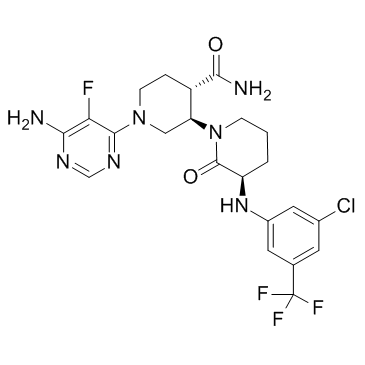1510829-06-7
| Name | vecabrutinib |
|---|---|
| Synonyms |
PQ7O0OB5GU
(3R,3'R,4'S)-1'-(6-Amino-5-fluoro-4-pyrimidinyl)-3-{[3-chloro-5-(trifluoromethyl)phenyl]amino}-2-oxo-1,3'-bipiperidine-4'-carboxamide vecabrutinib [1,3'-Bipiperidine]-4'-carboxamide, 1'-(6-amino-5-fluoro-4-pyrimidinyl)-3-[[3-chloro-5-(trifluoromethyl)phenyl]amino]-2-oxo-, (3R,3'R,4'S)- |
| Description | Vecabrutinib is a potent, noncovalent BTK and ITK inhibitor, with Kd of 0.3 nM and 2.2 nM, respectively; Vecabrutinib shows an IC50 of 24 nM for ITK. |
|---|---|
| Related Catalog | |
| Target |
IC50: 24 nM (ITK)[2] Kd: 0.3 nM (BTK), 2.2 nM (ITK)[1] |
| In Vitro | Vecabrutinib inhibits pBTK in human whole blood with an average IC50 of 50 nM. Vecabrutinib inhibits WT and C481S BTK with similar IC50s (pBTK IC50s: WT BTK 2.9 nM, C481S BTK 4.4 nM)[1]. In a recombinant kinase assay, IC50s of Vecabrutinib against WT BTK and C481S BTK are 4.6 nM and 1.1 nM. Vecabrutinib retains activity against the mutated BTK variant. Vecabrutinib is six times more potent than ibrutinib and greater than 640 times more potent than acalabrutinib against C481S BTK. Vecabrutinib demonstrates dose-dependent inhibition of BTK in primary patient CLL cells comparable to ibrutinib via immunoblot for BTK phosphorylation. Vecabrutinib decreases viability of primary CLL cells in the presence of HS5 stromal protection by 5.5%[2]. |
| In Vivo | Vecabrutinib has good oral bioavailability in rat and dog (%F ≥ 40%) and a terminal half-life of 5 to 6 hours. Vecabrutinib is well tolerated with continuous drug levels and at exposures much greater than those achieved for ibrutinib[1]. |
| References |
| Density | 1.5±0.1 g/cm3 |
|---|---|
| Boiling Point | 776.0±60.0 °C at 760 mmHg |
| Molecular Formula | C22H24ClF4N7O2 |
| Molecular Weight | 529.918 |
| Flash Point | 423.1±32.9 °C |
| Exact Mass | 529.161621 |
| LogP | 3.13 |
| Vapour Pressure | 0.0±2.7 mmHg at 25°C |
| Index of Refraction | 1.621 |
| Storage condition | 2-8℃ |
